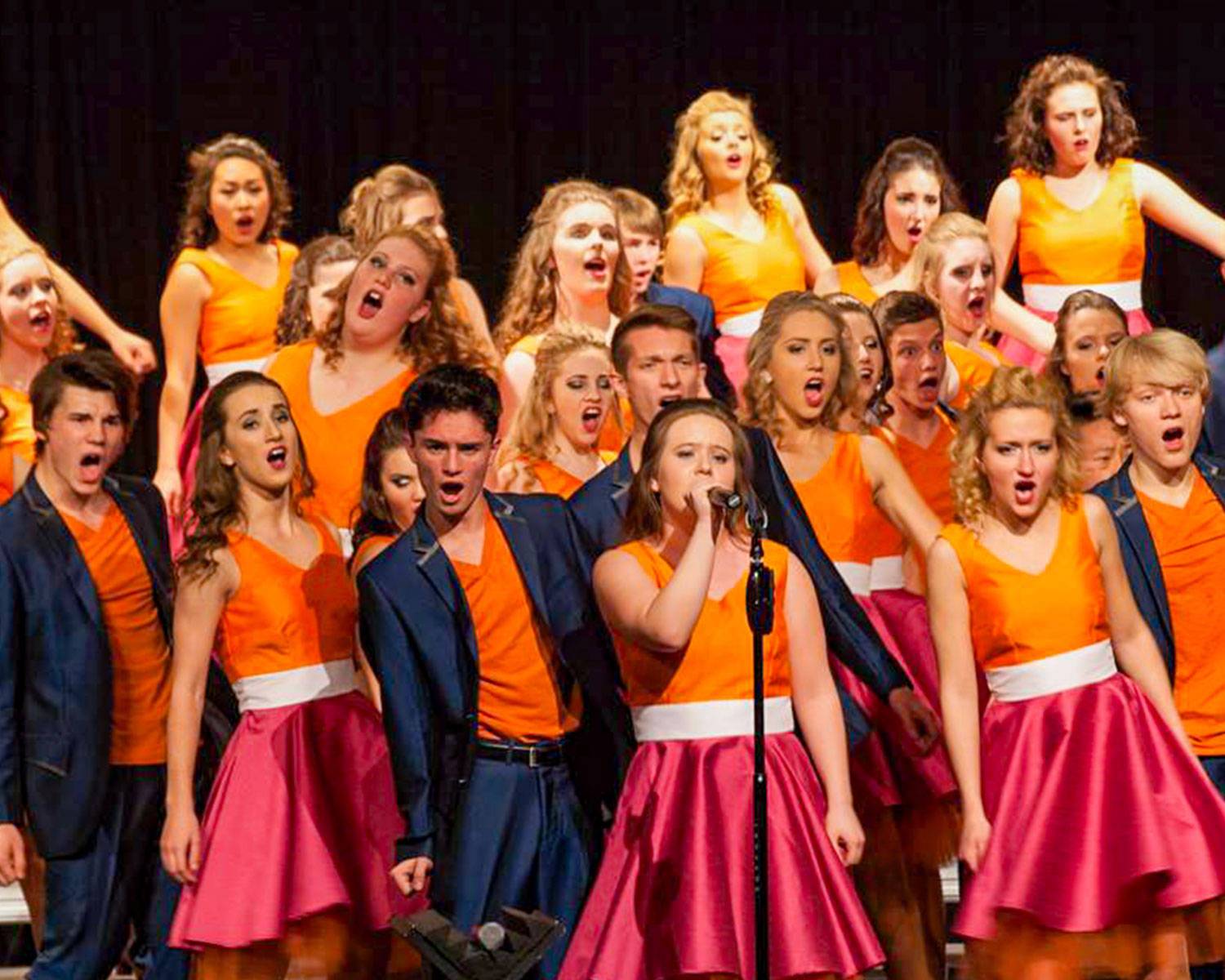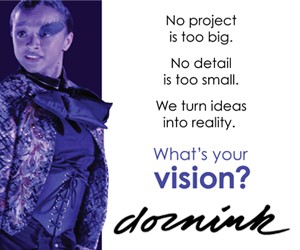
She became a business partner with her mother Faythe in 2005 at Dornink Costumes. They ran a retail shop and created custom pieces including bridal, evening, and cocktail dresses, costumes for show choirs, and specialty garments for local fundraisers. The retail side of the business closed in 2021 and now Sarah and her mother work almost exclusively for choirs.
Curious about Sarah’s journey, experience, and what uniqueness Dornink Costumes can bring to show choir, I spent some time talking with her.
Tell us about how you and your mother, Faythe, got into costume design.
My mom started the business when I was a kid. Custom dress design—bridal, evening, cocktail—was the main part of the business when she started. She started doing show choir when my older sister and I were in show choir, and that was a very easy transition because it was dresses. My mom went to my sister’s first show choir performance and got into it to help her daughter’s show choir look better.
Sounds like a natural progression. Your retail store closed in 2021. What was the reasoning for that?
Covid was the reason. We had to close in March like everybody did. Show choirs and schools were not in session that year, so 40 percent of our income was lost, and by the fourth quarter we couldn’t maintain the space we had. We had always planned for my mom to retire when our lease was up and go forward with just show choir. The plan got sped up a little bit with covid. My mother still helps me. She works about fifty percent of the time.
Oh, that’s so great, being able to work with your mom! What is unique about Dornink Costumes, other than it being a mother/daughter business?
What makes us unique is we don’t do standard show choir things. Directors come to me when they really want something theatrical that they can’t find anywhere else. They search me out when they want something that doesn’t exist, when they need something custom designed and well constructed. For example, last year Ankeny High School wanted 3-D fortune-teller shapes that were removable throughout the show. Their theme was a dystopian society, where the level of shapes they had and the color were representative of the hierarchy of society. They all started with no shapes and they would put the blue ones on if they were mid-level and if they were blue and gold they were at the highest level. I designed these 3-D shapes that could come off and on throughout the show. We ended up using craft paper with a waxed backing for the fortune tellers so it was stiff enough and didn’t rip. That was an interesting challenge, and the end result was really cool.
It sounds like you have a good time picking out what the material is going to be.
Yes! I do enjoy the production end of organizing and figuring it out, the engineering behind something like that is fun to me, almost as much fun as sketching a pretty dress. Earlier in my career, I would like to sit down and sketch. Now I really like it when someone brings me a really weird, hard idea and figuring out how to make it happen. I guess that math thing comes in—I do love solving problems, love a good puzzle.
You mostly do custom work. Do you also have ready-to-wear?
Yes, I have vendors I used when we had the store. It’s a great option for those directors who just want a pretty dress that looks great on stage and they can get it quickly, usually within a week, and in lots of different sizes and colors.
What about for the men in show choir?
I have vendors with ready-to-wear suits, from standard to more theatrical like jacquards and sequins, with button downs, even cargo pants. We can source all sorts of cool things ranging from suits to more casual items. I don’t enjoy making men’s suits from scratch when you can buy them so well made. The tailoring has so much structure and layers that it gets too expensive, especially when you can buy them and then just alter if you need to. You can add embellishments like piping and sequins or a satin ribbon pretty easily. I have made some, but they are not made with the level of detail as a ready-to-wear.
What trends are you currently seeing for show choir?
I would say a big trend for groups I worked with over the past couple of years is unisex. The 3-D shapes on jackets were for men and women. Ankeny is my school that does the most unusual things, and they are local so we can meet and hash out ideas. They’ve been focusing on unisex things, like jackets for guys and girls. This last year we did two different pants and two different tops for guys and girls and you could pick different ones.
It’s nice to be able to meet in person, and also virtually with video calls these days. What is your process for show choir designs, for both local and non-local directors?
I sketch the design based on what directors ask for and discuss choices of fabric. Once they approve the black-and-white sketch I will use Photoshop and put the color in and the fabrics so they can make sure it really looks like what they are envisioning, as much as you can in 2-D. Once that is narrowed down I make a sample. If they are local, they bring someone to try it on. If they are not local I can try it on my daughter and send pictures or maybe a video. They approve the sample and then we go into production.
What happens next?
If it’s local, often we will go and fit them at the school. If it’s not local I will get them all in, inspect them, put them on a dress form to make sure that everything did come in as I expected it to. Sometimes when you are working with a new pattern or fabric, the fit changes. Costuming is never perfect. Bodies change or fabric changes, or you put in a new fabric and it doesn’t do the same. There’s always problem solving and troubleshooting. We always do quality control when the garments get to us, then I ship them to the clients.
I’m sure the directors appreciate your attention to fit and function. I read that you are in your third year costuming for Ballet Des Moines. I’m curious, as a ballet dancer myself, how do you approach costuming what a ballet dancer would need versus what a show-choir performer would need?
It has been a learning curve of learning how ballerinas in particular need the costumes to move. Everything has to have spandex and stretch. It also depends upon what kind of piece we are doing, which has been interesting. For example, in The Nutcracker, a lot of the costumes are not stretchy at all. There are bodices that are made of boning and stiff fabrics. I’ve had to learn where that can be on the body so they can actually do all the movements they have to.
In the second act of The Nutcracker, Ballet Des Moines reimagined it and connected the score to animals. We have a betta fish, which was a super fun piece to create. I worked with the artistic director on the vision for the costume—here’s the choreography, and here’s my sketch, and how do we put them together in order to create a fin that looks like a betta fish swimming through the water? I ended up using this pleated organza that we cut and painted so it really looked like a tail fin of a betta fish. It was fun to see that design transform into the final piece, to work with the choreography and to work with the dancer on the stage.
Do you find a lot of crossover in the types of fabrics you use for ballet and for show choir?
A lot of my vendors are the same ones. For ballet we use less sequins. Also it’s a small company—I don’t ever need to make 30 pieces of the same thing like I do for show choir.
During our chat—and later looking through the gallery on the Dornink Costumes’ website—it was obvious that Sarah truly enjoys costume design and design challenges. A few of her unique designs are a dress made from bacon for the Des Moines Annual Bacon Fest, a snake charmer hat made from bubble wrap and signed by Katy Perry for the Bubble Ball fundraiser, and costumes for dancers for the opening number of the FIFA World Cup Official Draw. Find out more about those projects at dorninkcostumes.com/projects/. Contact Sarah directly at sarah@dornink.com to set up a consultation for your next one-of-a-kind costume.











